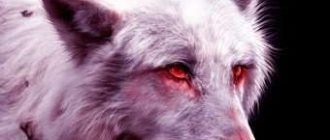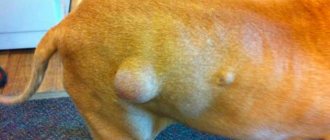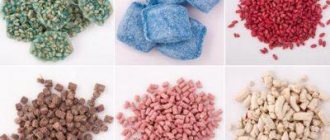Functions of the testes in the body of male dogs
In dogs, like in any other species of mammals, the reproductive (genital) system consists of internal and external genital organs (testes, epididymis, vas deferens, scrotum, penis, prepuce, gonads).
The testes (testicles, testicles) are a sac-like protrusion of the abdominal cavity. They have an ovoid shape. Located in the scrotum - a muscular sac. They are the main paired reproductive organs of the male, endocrine glands.
Functions of the testes in the body of male dogs:
- Production of male sex hormones – androgens (testosterone). Formed in the interstitial tissue of the testes. Testosterone is involved in the production of sperm, has an anabolic effect, is responsible for sexual reflexes, and determines sexual behavior.
- Formation, primary maturation of germ cells - sperm in the convoluted tubules of the testes.
Treatment of cryptorchidism in dogs
1. Conservative (therapeutic)
In the conservative treatment of cryptorchidism in males, massage courses and hormone therapy are used. The earlier treatment is started, the better the prognosis. The greatest result (about 20%) can be achieved in patients under the age of 6 months; later, when the inguinal canal closes, the effectiveness of the procedures decreases significantly. The use of massage is rational if the testis can be palpated and it is in close proximity to the scrotum. During the procedure, the testis is gradually pulled up in the caudal direction, lowered into the scrotum and held there for some time. The more often the sessions are performed, the more effective the treatment.
Hormone therapy uses drugs such as choriogonadotropin or gonadotropin-releasing hormone. The drugs increase the production of endogenous luteotropic hormone, which promotes testicular descent. It should be noted that hormone therapy is used only when the disease is caused by a disruption of the endocrine system. If cryptorchidism is caused by other reasons, then the use of drugs may cause an acceleration of neoplastic changes in the undescended testis. Such treatment should be carried out under the strict supervision of a veterinarian.
2. Orchiopexy
Orchidopexy is an operation whose purpose is to bring down the testis and secure it in the scrotum. There are various methods for carrying out this procedure. In terms of invasiveness, trauma and duration, this surgical intervention is practically no different from castration. There is evidence of fruitful matings and a gradual improvement in the quality of spermatogenesis in 20-30% of operated male dogs. Considering the hereditary nature of the disease, the use of orchiopexy in most countries, including the Russian Federation, is recognized as fraud and is prohibited by law. It is recommended to cull the male dog from breeding and castrate it. This operation is not performed in our clinic.
3. Orchiectomy (castration)
An orchiectomy is an operation to remove the testes. It is performed under general anesthesia using sedatives and painkillers. There are various techniques for performing orchiectomy and their choice depends on the type of cryptorchidism. With the inguinal type, the operation does not require opening the abdominal wall (the operation is not abdominal), the invasiveness and trauma are low, the duration is about 15-25 minutes, that is, the same as during castration of a normal male dog. In the treatment of intra-abdominal cryptorchidism, abdominal surgery is performed. Its duration (30-60 minutes) and complexity vary depending on the location of the testis in the abdominal cavity.
What is orchitis and why is it dangerous?
Orchitis is a disease of the reproductive system of males, characterized by inflammation of the gonads - the testes. In males, the disease occurs predominantly in an acute form, less often in a chronic, more severe form. Dogs of all breeds and age groups are affected, but most often orchitis is diagnosed in dogs after 4-6 years of age.
In veterinary medicine, orchitis in males is classified into unilateral and bilateral. That is, the inflammatory process affects one or two testes. The disease is often accompanied by epididymitis (inflammation of the seminal appendages).
Important! Orchitis poses a particular danger to males who take part in breeding. If treatment is not started in time, this pathology will put an end to the reproductive life of the pet, leading to infertility.
Orchitis can cause sepsis, which most often leads to death. Acute inflammation turns into chronic, purulent. The disease is complicated by fistulas and abscesses in the scrotum. Purulent orchitis without proper treatment provokes tissue necrosis.
STD
The reason why the skin on the dog's testicles is red,
It often becomes an infection that the dog received during mating. The danger is that the incubation period can range from 2 to 8 months, although the dog is capable of infecting its partners during this entire time. The following diseases are transmitted during mating:
- Venereal sarcoma. The pathology, which occurs only in dogs, has all the properties of an oncological disease except the ability to metastasize. The localization site, the mucous membrane of the genital organs, resembles a bright red cauliflower. By licking, the dog transfers living tumor cells to other places, increasing the affected area. Dogs leading a free lifestyle are more often infected. Surgical treatment does not give positive results. In veterinary practice, 95-100% effectiveness has been achieved through the simultaneous use of radiation and chemotherapy.
- Gonococcal urethritis (gonorrhea). It manifests itself as swelling and redness of the genitals, painful urination. The method of treatment is determined by the doctor.
- Herpes .
The disease occurs secretly, but sometimes ulcerations and red spots can be seen on the genitals of male dogs. Treatment is carried out with antiviral veterinary drugs under the supervision of a specialist.
It is not possible to independently diagnose an STD in your pet; if you suspect something is wrong, you should immediately go to an appointment with a veterinarian. It is recommended to do the same before each mating, as a preventive measure.
Causes of testicular inflammation in dogs
In most cases, bacterial and viral local infections lead to the development of pathology.
Causes of testicular inflammation in dogs:
- diseases, pathologies of the genitourinary system, urinary tract infections (cystitis, urethritis, urocystitis, posthitis, balanitis);
- bruises, penetrating injuries of the scrotum;
- infections affecting the kidneys, urethra, bladder, liver;
- hernias, benign, malignant neoplasms;
- dermatitis of the scrotum;
- inflammatory processes in the testicles;
- torsion of the spermatic cord;
- inflammation of the prostate (prostatitis);
- dropsy of the testicular membrane (hydrocele);
- autoimmune diseases;
- uncontrolled matings;
- group keeping of dogs in unfavorable conditions;
- failure to comply with hygiene rules;
- prolonged hypothermia, weakened immunity, decreased resistance.
Based on the causes that provoke the disease, orchitis can be traumatic, infectious (bacterial), or systemic.
Orchitis in a male dog can occur against the background of mycoses, chlamydia, brucellosis, leptospirosis, canine distemper, other diseases of a viral-bacterial, parasitic nature that affect the entire body, as well as diseases that are accompanied by high fever.
Bites of blood-sucking insects in the scrotum area, for example, ticks, can also cause orchitis.
There is no breed or genetic predisposition to orchitis. At the same time, according to statistics, dogs prone to allergies, dermatitis, dermatoses, as well as large, giant breeds of dogs, as well as homeless street animals are at risk.
Neoplasms
The most dangerous are tumor diseases of the genitals. If you notice a change in the color of the testicles, determine by touch whether a cyst or tumor is causing their redness. If you find a lump, be sure to show your four-legged friend to the doctor. After removal of a cyst or benign formation, the body will recover quickly. If oncology is diagnosed, long-term treatment will be required.
Prevention of pathologies of the dog’s genital organs can be considered:
- avoiding contact with street animals;
- selection for mating of a potentially healthy partner;
- easy disinfection of the pet’s mucous membranes and genitals after walks;
- visiting a veterinarian for a preventive examination.
The best prevention of any disease is a healthy diet and a healthy lifestyle.
Testicular cancer in dogs is an oncological disease characterized by the appearance of a pathological neoplasm in the testicles, which is formed from the cellular structures of the gonads of animals. According to statistics, tumors of the testes make up 15-25% of all cancers of our smaller brothers. In veterinary practice, this pathology occurs in males of various age groups, but most often a tumor of the testes is diagnosed in uncastrated males after six to eight years. The main danger is the development of metastases. Moreover, if you identify signs of cancer in time, contact a veterinarian and begin treatment, the prognosis in most cases is favorable.
Not much different from human cancer. The disease develops due to cellular mutations that occur at the DNA level. Irreversible changes occur in the cells, as a result of which they cease to perform their natural functions. Due to rapid division, the number of mutating cellular structures increases, and they form into separate groups - tumors and daughter formations (metastases).
Neoplasms have
a malignant and benign nature
. Benign ones do not penetrate beyond the tissues in which they develop, so the prognosis in most cases with timely treatment is favorable.
Important! Pathological neoplasms compress tissues, blood vessels, nerves, displace, replace, and destroy healthy cells, which leads to disruption of the functioning of the affected organ.
Like any disease, a testicular tumor in a dog develops under the influence of various unfavorable exo- and endogenous factors, among which are:
- hormonal imbalance;
- genetic predisposition;
- age-related changes;
- endocrine diseases (hypoganadism);
- chronic pathologies of the reproductive system organs (inflammation of the appendages);
- severe injuries to the peritoneum and scrotum.
Testicular cancer is most often diagnosed in cryptorchid males. With cryptorchidism
, which can be unilateral or bilateral, one or two testes do not descend into the scrotum, but remain in the abdominal or groin area. The disease is transmitted genetically.
Important! Various forms of cryptorchidism in dogs increase the risk of neoplasms in an undescended testicle by 15 times. In 30-35% of cases, testicular cancer is diagnosed in males with bilateral cryptorchidism, in which both testicles are located in the intra-abdominal cavity.
Testicular cancer in dogs often develops after cancer, since the disease is recurrent, and also against the background of some viral, bacterial diseases, and infections. Classification of testicular cancer
Pathological neoplasms in the testes have different histological structures and etiopathogenesis. There are germinogenic, which arise from the seminiferous epithelium, and non-germinogenic, which are formed from the stromal epithelium, cellular structures that produce hormones.
There are three main types of testicular cancer diagnosed in dogs:
- Leydig tumor
(leydigoma). They develop in the descended testicles of males from interstitial cellular structures. They do not reach large sizes. They produce androgens, which leads to the formation of a constant hormonal background, which provokes the formation of tumors. Leydigomas are benign tumors and do not metastasize. - Seminomas.
They are formed from the cellular structures of the spermatic epthelium in the undescended testicle. Reach significant sizes. They do not produce hormones. Most often noted in males after 9-11 years. Metastasizes rarely, mainly to regional lymph nodes. - Sertoliomas.
Neoplasms that are formed from Sertoli cells. Produce estrogens. Changes in hormonal levels suppress secondary sexual characteristics in males. - Androblastomas
. Characterized by metastasis to other internal organs. Produce estrogens.
It is worth noting that tumors in dogs are quite often formed by various types of cancer cells. For example, in practice there are tumors of the testis (leidigoma) and cancer of the appendages. The most common type of testicular cancer in animals is germ cell tumors.
Symptoms and first signs of the disease
The symptoms of orchitis largely depend on the form, stage of the disease, the state of the immune system, age, and individual and physiological characteristics of the dog.
Symptoms and first signs of the disease, including:
- change in behavior (lethargy, depression, apathy, followed by anxiety);
- increased thirst;
- loss of appetite, complete refusal to eat, weight loss;
- poor coat condition;
- stiff gait;
- lethargy, drowsiness;
- problems with urination;
- change in urine color;
- redness, cyanosis of the scrotum;
- pain on palpation of the testes;
- increased temperature, fever;
- an increase in volume of one or both testicles.
Diagnosis of inflammation in a clinical setting
The diagnosis of orchitis in dogs is made by a doctor based on medical history and a number of diagnostic and laboratory tests.
Diagnosis of inflammation in a clinical setting includes:
- Ultrasound of the testes, prostate, peritoneum;
- Radiography;
- Serological studies (blood and urine are taken for analysis);
- Differential diagnosis;
- Biopsy.
For research, seminal fluid, scrotal tissue, material from open wounds for culture, and sperm are taken. A biochemical, general blood test, and urine test are mandatory.
Treatment regimen for testicular inflammation in dogs
The treatment regimen for testicular inflammation in dogs depends on the cause, form, and stage of the inflammatory process. Prescribed by a veterinarian based on diagnostic results, taking into account the age and individual characteristics of the animal.
The following are used in the treatment of orchitis:
- Broad-spectrum antibiotics in injections, tablets for orchitis of infectious etiology, fluoroquinols, cephalosporins. The course of antibiotic therapy takes from 5-7 days to 2-3 weeks.
- Etiotropic therapy (specific therapy), hyperimmune serum at the beginning of the disease.
- Anti-inflammatory drugs.
- Painkillers.
- Hormones.
- Novocaine blockades.
- Corticosteroids.
- Tissue therapy.
- Antifungal medications for orchitis caused by mycoses.
- Cooling, warm wet compresses.
Important! In case of acute inflammation, irritating ointments (ichthyol) should not be used, since the skin of the scrotum is delicate and thin, so eczema can develop.
Additionally, immunostimulants and hepatoprotectors are used in therapy for long-term antibiotic therapy. Droppers may be prescribed to relieve intoxication. For autoimmune orchitis, immunosuppressants (medicines that suppress immune responses) are used.
Testicular inflammation
In our country, many earn their living by breeding and selling purebred dogs. It is quite natural that in this case special attention is paid to the health of pets, since diseases can ruin a businessman. Orchitis in dogs is especially dangerous for breeders, since this pathology can put an end to the reproductive function of a stud dog.
Basic information
- Orchitis is an inflammatory disease of the testes (testes) that is quite common in dogs. It can be unilateral or bilateral, often accompanied by epididymitis, since the testis and its appendages are naturally closely connected to each other. What are the causes of this pathology?
- In dogs, orchitis is usually caused by a bacterial infection. Bacteria penetrate into the testes through sexual contact, diseases of the urinary system and kidneys, and injuries. Very often, orchitis is caused by canine distemper virus, mycosis (blastomycosis and coccidioidomycosis), and ehrlichiosis.
- It is important to remember that not only injuries with penetration of foreign objects into the scrotal cavity or the testicle itself are dangerous, but also its crushing. The fact is that in the latter case, orchitis may be in the nature of an autoimmune pathology. The disease can be acute or chronic. Free-ranging males are at greatest risk.
Also at risk are older animals with chronic urinary tract infections.
Dogs often exhibit different clinical signs, as they depend on the general condition of the animal, age and etiology of the disease.
Orchitis is inflammation of the testicle. It occurs as a complication of infectious diseases (influenza, tuberculosis, etc.), or with trauma to the scrotum.
The disease develops rapidly: the testicle increases in size, becomes dense, sharply painful, and the temperature rises. Anti-inflammatory therapy is carried out, bed rest is observed, and a jock strap is worn. After the inflammatory phenomena subside, you will need to wear a jockstrap and prohibit sexual activity until the doctor’s permission.
When inflammation of the testes continues for several days, warm, moist compresses can be used, but irritating ointments (ichthyol and camphor) should not be used for this disease, since they cause excessive irritation of the sensitive scrotum and lead to the appearance of oozing eczema.
It is recommended to apply a well-lined bag with cotton wool - a suspensor, in which the scrotum and testes should hang freely. The suspensorium creates protection for the testes from external irritants, and also makes it impossible to lick the ointment from the scrotum. Such bags of different sizes can be purchased at the pharmacy.
They are attached using four ribbons on the dog's back, and in order to prevent the ribbons from being pulled back, you can additionally connect them to the collar. During the treatment period, you need to provide the dog with more rest and less movement.
Orchitis in dogs is characterized by an inflammatory process in the testicle. All dog breeds are susceptible to the disease, including the Yorkshire Terrier. In most cases, adults are affected.
List of drugs and antibiotics
The frequency of the course and dosage of medications is prescribed by the attending veterinarian.
List of drugs and antibiotics:
- streptomycin;
- penicillin;
- ofloxacin;
- neopen;
- cobactan;
- gentamicin sulfate;
- intramycin;
- analgin;
- amidopyrine;
- choriogonadropin (hormones);
- Traumeel-gel;
- Syntomycin, baxin ointment.
For purulent orchitis, antibiotics are used in combination with sulfonamides and infusion therapy. Any medications for the treatment of testicular inflammation in male dogs are prescribed on an individual basis.
Caring for a sick dog at home
If your dog is diagnosed with orchitis, be sure to consult your veterinarian on how to care for your beloved pet. Caring for a sick dog at home comes down to creating optimal living conditions. Provide your dog with peace, avoid hypothermia, and protect him from stress. If there are other animals at home, it is better to isolate the sick dog during treatment.
Important! To prevent your dog from licking the testicles or licking off topical medications, use an Elizabethan collar.
Stages of the operation
- First, the doctor examines the animal.
- The next step is to get tested to prevent the risk of negative consequences from anesthetics. A blood test is done, as well as a biochemical analysis if the animal is healthy. And urine, X-ray, EchoCG, biochemical blood test, OBC - for sick animals.
- The puppy must be vaccinated 20-30 days before surgery.
- Deworming should also be carried out 10 to 14 days before vaccination.
- The pet must be washed the day before surgery.
- And for 10 - 12 hours, the dog must be on a strict diet and reduced fluid intake for 6 hours.
After the operation, the dog is admitted to the hospital, where it regains consciousness. This takes from 30 minutes to 2 hours. It all depends on how powerful the anesthesia was, what drugs were used on the dog, etc. It can take 6 to 12 hours for the medications to completely leave the body.
During this rehabilitation period, you can leave the dog in the hospital, but usually this is not necessary. You can also take care of your pet at home. And for this it is necessary to treat the sutures with antiseptic substances 1 – 2 times a day (for each case, the veterinarian prescribes different drugs). If necessary, the doctor may prescribe antibacterial agents and painkillers. To prevent your dog from licking or untying the seams, you need to wear an Elizabethan collar. The sutures are removed by a veterinarian 10–14 days after surgery.
Consequences of the disease
If the owner starts cryptorchidism in dogs, the consequences can be very sad. The disease should be diagnosed and treatment should begin at 6–7 months from birth. Then the inguinal canal is not yet closed and the testes can be lowered into place with minimal risk for the dog. But if the disease is neglected, then the failed testes in the scrotum can cause a malignant tumor. This will become a real problem, since even castration will not save the dog.
Prevention measures
Preventive measures will help protect the male dog from inflammatory processes in the testes. Take care of your dog's hygiene, avoid hypothermia and accidental mating with street dogs. Do not skip scheduled vaccinations, as most often in male dogs orchitis occurs due to infections.
Inspect your dog after every walk for injuries or damage. Treat against ectoparasites. Do not allow fights with other male dogs.
If a male dog is of no breeding value and you do not plan to breed a dog, castrate your pet.
Take your dog to the clinic twice a year for routine checkups. If you notice the first signs of illness or any illness, contact your veterinarian.
Symptoms of orchitis in dogs
Symptoms of orchitis are localized in the scrotum area of a male dog. The disease can be recognized by swelling of the testes, irritation on the skin of the scrotum, as a result of which the dog constantly licks it. Upon examination, open wounds may be detected.
When feeling the testes, the dog experiences severe pain. There are also non-localized symptoms such as pain and fever. The dog sleeps a lot, refuses to walk and eat. He sits down very carefully, and his hind legs are clearly tense. With chronic orchitis, the dog may be infertile.
For a correct diagnosis, you need to take your dog to the veterinarian. He will examine the animal and prescribe tests to rule out various diseases that could cause orchitis. With infectious orchitis, a dog's blood test may show an elevated level of white blood cells.
With cystitis or prostatitis, blood, increased amounts of proteins or pus will appear in a urine test. An antibody test will show whether infectious organisms may be causing orchitis. An ultrasound examination of the testes and prostate may also be prescribed. If a dog has an open wound on the testis, it is examined for bacterial infections.
Treatment and care
Treating a dog for orchitis depends on whether the dog is used as a puppy breeder.
If the dog is not involved in breeding, it is better to castrate it. If one testicle is involved and the problem affects one testicle, then partial castration is a good way out of the situation. After surgery, the dog must be given antibiotics for three weeks. Treatment with antibiotics without castration rarely leads to recovery. But even unilateral castration can lead to infertility. In any case, after three months of treatment, the dog’s sperm will be checked for viability. To prevent your dog from remaining infertile, it is better to regularly examine it and treat wounds in a timely manner and prevent infections.
What is orchitis in dogs and what does this disease mean for your pet?
Orchitis is a disease that occurs in a male dog as a result of an inflammatory process in the testicle.
In most cases, the disease is observed in animals over the age of four years, regardless of the breed and size of the animal.
The disease can occur in both acute and chronic form, have unilateral or bilateral development, and be accompanied by inflammation of the appendages - all this depends on individual factors. The acute form is more common. If the disease is chronic, it is more difficult to detect - it develops slowly, leading to scarring of the testes and, as a result, to infertility.











